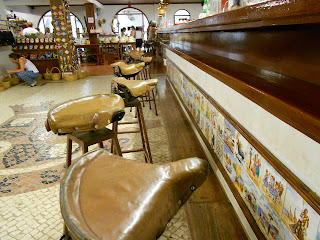Saturday, February 04, 2012
Wall of death
The Diamond Maruti Car Circus in Delhi ... These death defying bad boys drive a wonky Nissan all over your foolish health & safety regulation ...
Thursday, February 02, 2012
Wednesday, February 01, 2012
Tuesday, January 31, 2012
Bullfight - Prime Rib Strikes Back
Most Portuguese bullfights are held in two phases: the spectacle of the cavaleiro, and the pega. In the second stage, called the pega (holding), the forcados, a group of eight men, challenge the bull directly without any protection or weapon of defence.
The front man provokes the bull into a charge to perform a pega de cara (face grab). The front man secures the animal's head and is quickly aided by his fellows who surround and secure the animal until he is subdued. Forcados are dressed in a traditional costume of damask or velvet, with long knitted hats as worn by the campinos (bull headers) from Ribatejo.
The bull is not killed in the ring and, at the end of the corrida, leading oxen are let into the arena and two campinos on foot herd the bull among them back to its pen. The bull is usually killed, away from the audience's sight, by a professional butcher. It can happen that some bulls, after an exceptional performance, are healed, released to pasture until their end days and used for breeding.
The front man provokes the bull into a charge to perform a pega de cara (face grab). The front man secures the animal's head and is quickly aided by his fellows who surround and secure the animal until he is subdued. Forcados are dressed in a traditional costume of damask or velvet, with long knitted hats as worn by the campinos (bull headers) from Ribatejo.
The bull is not killed in the ring and, at the end of the corrida, leading oxen are let into the arena and two campinos on foot herd the bull among them back to its pen. The bull is usually killed, away from the audience's sight, by a professional butcher. It can happen that some bulls, after an exceptional performance, are healed, released to pasture until their end days and used for breeding.
Monday, January 30, 2012
Subscribe to:
Comments (Atom)






